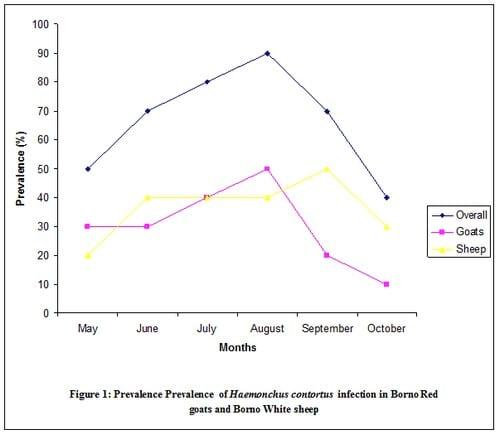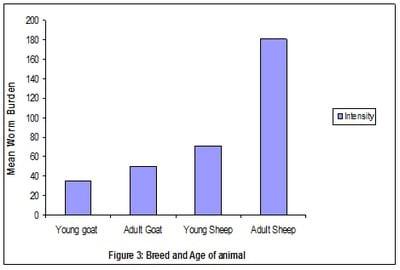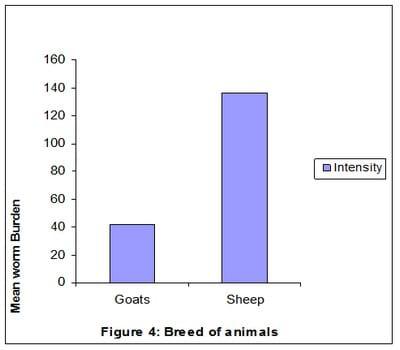Haemonchus contortus infection in ruminants
Prevalence and intensity of Haemonchus contortus infection in two breeds of small ruminants in Maiduguri, an arid zone of Northern Nigeria
Published: November 16, 2011
By: Musongong, G. A (University of Maiduguri), Ndofor-Foleng, H. N. (University of Nigeria), Abdurashid M. (University of Maiduguri)
Abstract
The prevalence and intensity of Haemonchuscontortus in two breeds of small ruminants namely Borno Red goats and Borno White sheep in Maiduguri, an arid zone of Nigeria, were investigated in the rainy season (May - September) of 2010. A total of 60 abomasa were purchased from the central abattoir in Maiduguri. Thereafter they were processed in the laboratory for total worm count. Results showed that both breeds of small ruminants were infected with H. contortus during the rainy season and both prevalence and intensity of infection in both breeds were highest during the month of August. However significantly (t < 0.05) more sheep, 22 out of 27 (81.5%), than goats, 18 out of 33 (54%), were infected and the mean monthly intensities of infection were 136.59±35.15 worms for sheep and 41.85±12.48 worms for goats. Although the overall intensity of infection was light for both sheep and goats it was concluded that chronic Haemonchuscontortus infection coupled with food scarcity in the dry season especially in an arid environment such as Maiduguri where the dry season is sometimes as long as 9 months is a potential constraint to successful production of these animals and more so of sheep than goats.
Keywords: Abomasa, Borno Red goats, Borno White sheep.
Introduction
Humid and sub humid environments favour the development and survival of infective stages of gastrointestinal nematodes in general and Haemonchuscontortus in particular. Haemonchuscontortus is a principal member of the trio (H. contortus, Trichostrongyluscolubriformis and Oesophagostomum) known to be the major aetiological agents of parasitic gastroenteritis (PGE) in small ruminants in Nigeria (Chiejina, 1986). Haemonchosis is the most highly pathogenic strongyle nematode infection of sheep and goats (Soulsby, 1982) and the survival of H. contortus in small ruminants seems to be breed-dependent and genetically based (Chiejina et al., 2004) and is detrimental to their health and productivity. Furthermore the survival mechanisms in small ruminants in arid environments are not fully understood.Infection with these parasites in general and H. contortus in particular constitutes a serious economic constraint to small ruminant production.
The prevalence of gastrointestinal nematodes (GIN) in tropical and sub-tropical areas has adversely affected the production potential of sheep and goats, leading to countless deaths and insidious economic losses in livestock sector. Among GIN, Haemonchus contortus considered main culprit causing anaemia and hypoproteinaemia in small ruminants (Oneyenwe et al ., 2005).
Efforts are now being made to selectively upgrade and rear Haemonchus resistant goat and sheep breeds (Shavulimo et al., 1988; Fakae et al., 2003). The frequency of drug administration, under dosing, prohibitive cost of chemotherapy and, presently, the influx of fake and adulterated drugs in Nigeria had given rise to the development of resistance to the currently used anthelminthics by the worm (Ikeme, 1997). An alternative approach is urgently needed, therefore, to check the rising frequency of resistant genes in the nematode population (Ikeme, 1997).
Recently it has been shown that Nigerian West African Dwarf (WAD) goats show natural resistance and resilience to H. contortus infection, an attribute known as haemonchotolerance (Fakae et al.,2003) but that this response is highly variable in individual animals, thus suggestive of a genetic basis. There is a paucity of information on the responses of Borno Red goats and Borno White sheep to haemonchosis. The present study was carried out to determine the prevalence and intensity of H. contortus in two breeds of small ruminants in an arid zone of Nigeria as a first step to understanding the responses of Arid zone breeds of small ruminants to Haemonchuscontortus infection.
Materials and Methods
The study area
Maiduguri is located between latitude 10-13o N and longitude 15-17o E. The vegetation of this arid zone of Nigeria is mainly sudanian undifferentiated woodland. This is patched with montane, edaphic grassland mosaic and brush and thickets (Bouin et al., 1994). The annual rainfall ranges from 15mm at the start of the rainy season (May) to a peak of 80mm in the rainy season (August). Dry season daily temperatures sometimes are up to 45 o C in the dry season.
Sample collection and analysis
During the rainy season (May to October) of 2010 a total of 60 abomasa (27 of Borno White sheep and 33 of Borno Red goats) were randomly purchased from the central abattoir in Maiduguri. Ten abomasa were purchased each month and brought to the laboratory in the Department of Biological Sciences of the University of Maiduguri. The sex of the sheep or goat was noted and marked on the container. Thereafter each abomasum was processed for worm count as described by Hansen and Perry (1990). Before flaying and dressing the animal, each abomasum was ligated at about 2 cm beyond the fundic and the pyloric ends of the gastrointestinal tract and excised. This was to prevent the influx or reflux of the worms (if any) from the abomasum into the adjacent chambers during handling. The abomasum was longitudinally slit open. In the laboratory, 100-mesh sized sieves were used to repeatedly wash and recover the worms until only the faecal debris was left. The worms from individual sheep or goats were then picked out of the abomasal content with the aid of a stereo microscope and forceps into a Petri dish containing a little water and counted. Counts were recorded as male or female worm and the female to male ratio calculated. When counts could not be done that day the worms were preserved in 10% formalin for counting the next day. The prevalence and intensity of infection expressed as percentage of animals infected and total worm burden of each animal respectively. Differences in prevalence and intensity of infection were compared between sheep and goats using the student t-test. Descriptive statistics were calculated and presented as graphs.
Results
A total of 60 abomasa were examined during the six months of study. Results show that Haemonchuscontortus is a common parasite of these breeds of small ruminants. However more sheep, 22 out of 27 (81.5%), than goats, 18 out of 27 (54%), were infected ( Figure 1). The monthly mean worm burden (Figure 2) and the overall mean burden of 136.59 ± 35.15 (n=27) for sheep were significantly (t < 0.05) higher than the overall mean worm burden of 41.85 ± 12.48 (n=33) for goats. Figure 3 shows that these burdens were influenced by age of sheep. Older sheep harboured more worms burden (181.38 ± 55.10) than young sheep (71.46 ± 23.62). Age did not significantly influence prevalence and intensity of infection in goats although older goats tended to harbour more worms (49.63 ± 17.18) than younger goats (34.53 ± 4.46). Individual worm burdens were markedly variable. The highest worm burdens were recorded in August (rainy season) while the lowest burdens were recorded in May and October (start and end of rainy season respectively) for both sheep and goats.
The mean worm burdens ranged from 3.80 ± 3.60 to 108.17 ± 47.64 for goats and 17.00 ± 8.48 to 369.00 ± 164.57 for sheep in October and August respectively. Whereas H. contortus tended to be more prevalent in male goats (11/33 = 33.3%) than in female goats (7/33 = 21.2%) there was no difference in prevalence of the parasite in female (12/27 =44.4%) and male (10/27 =37%) sheep. There were more female worms than male worms in both sheep and goats and the female to male ratio was 1.76. Significant difference was observed for H.contortus infection level among the 2 breeds of small ruminant (Sheep and goats) with the sheep a greater warm burden than the goats (Figure 4).
Discussion
The results of this work suggest that there is chronic haemonchosis in the sheep and goats in Maiduguri, influenced by the arid climate of this zone of Nigeria. Furthermore good milk producers such as the sheep and goats of the arid zone are also prone to harbour persistent and prolific worm burdens though low in the present case. These may eventually build up to significant worm burdens.
Chronic haemonchosis is characterised by low worm burdens accompanied by chronic gastritis, chronic blood loss and progressive weight loss and stunting of growth. This condition does not show the anaemia and oedema usually associated with haemonchosis (Allonby, 1974; Allonby and Urquhart, 1974; 1975). Death of untreated animals suffering from chronic haemonchosis may occur after about 6 months especially during spells of dry weather.. The higher worm burdens of sheep than those of goats may explain why goats outnumber sheep in Nigeria according to Bouin et al. (1994) when the pathogenic consequences of haemonchosis are taken into account. Within an arid zone such as Maiduguri two factors namely resumption of development after hypobiosis of ingested infective larvae (Schillhorn van Veen, 1978) and trickle infection from increased populations of infective larvae on pasture during the favourable rainy season seem to play major roles in the gradual build-up of chronic infections with low worm burdens in these animals. Obviously these animals trickle-infect themselves from the start of the rainy season with infective larvae developing on pasture from the eggs laid and passed out in the faeces by maturing worms that have resumed development especially in the sheep, after arrested development, at the start of the favourable rainy season, thus resulting in peak worm burdens in August (Figure 2). Haemonchuscontortus is a prolific egg producer and one female worm can produce up to 10000 eggs per day, a probable reason why female worms tend to suck more blood than males. Thus a higher population of female than male worms is another contributory factor to blood loss and anaemia. About 400 worms can suck up to 6ml of blood per day (Smyth, 1976) and at peak infection such populations may remove up to one fifth of the circulating erythrocytes volume per day (Georgi and Georgi, 1990), each parasite being capable of sucking up to 0.05 ml of blood per day (Soulsby, 1982). This means that even low chronic burdens such as those recorded in the present work are economically important, causing excessive morbidity in the short run and mortality in the long run. These results suggest that sheep and goat farmers in Maiduguri should pay therapeutic attention to their animals in the month of August when worm burdens are highest because high burdens in the ensuing long, dry season coupled with food scarcity may restrict profitable sheep and goat production. Peak prevalence in the same August means that more animals are acquiring chronic doses.
The disparity in worm burdens of sheep and goats, being lower in goats, can be attributed to the browsing habit of goats apart from any genetic relationship. They feed more of the time on tree foliage either on stem or fallen dry leaves thus reducing the chances of ingesting infective larvae (Devendra and McLeroy, 1982). Grazing sheep are more likely to ingest larvae from grass which will account for the higher burdens in sheep. In addition sheep are herded with cattle increasing their chances of acquiring more infective larvae than goats do.
The goats in Maiduguri seem to show similar responses to H. contortus infection to Nigerian West African Dwarf goats which have been shown to be more adapted to and so can tolerate natural and experimental infections with the local strain of H. contortus than with other strains (Fakae et al ., 1999; Chiejina et al., 2002). This similarity in response is another factor which may account for the higher worm burdens in sheep relative to those in goats and which need further investigation through controlled experimentation.
Conclusion
Haemonchosis can be more economically important in sheep production than in goat production in Maiduguri, an arid zone of Nigeria. Yet susceptible breeds of sheep and goats can benefit from haemonchotolerance through a cross breeding programme between them and haemonchotolerant counterparts if there is a genetic basis for this attribute. Goat production will be more profitable than sheep production in a zone where both sheep and goats are likely to suffer from chronic haemonchosis.




References
Allonby, E.W. (1974). Ovine haemonchosis: Epidemiology, clinical signs and diagnosis. In: Helminth diseases of cattle, sheep and horses in Europe (Eds G.M. Urquhart and J. Amour) pp 56-63, Robert MacLehose and Co, Ltd, Glasgow.
Allonby E.W., Urquhart G.M. (1974). Haemonchosis in sheep in Africa. In: Parasitoses of Man and Animals in Africa (Eds C. Anderson and W.L. Kilama) pp37-40. East African Literature Bureau, Nairobi.
Allonby E.W., Urquhart G.M. (1975). The epidemiology and pathogenic significance of haemonchosis in a Merino flock in East Africa. Veterinary Parasitology1: 129-143
Bouin D., Wint W., Blench R.,Wolley, E., (1994). Nigerian Livestock Research Survey. World Animal Review78:49-58.
Chiejina S.N., Fakae, B.B., J.M. Behnke, P.A. Nnadi, G.A. Musongong, D. Wakelin (2002). Expression of acquired immunity to a local isolate of Haemonchus contortus by the West African Dwarf goat. Veterinary Parasitology104:229-242
Chiejina S.N. (1986) The epizootiology and control of parasitic gastroenteritis of domesticated ruminants in Nigeria. Helminthological Abstracts (Series A) 55: 413-429
Chiejina S.N. (1987). Some parasitic problems of intensively managed West African Dwarf sheep and goats in Nsukka eastern Nigeria. British Veterinary Journal. 143:246-252
Fakae, B.B., Chiejina, S.N., Behnke, J.M., Ezeokonkwo, R.C., Nnadi, P.A., Onyenwe, W.I., Gilbert, F.S., Wakelin, D. (1999). The reponse of Nigerian West African Dwarf goats to experimental infections with Haemonchus contortus. Research in Veterinary Science66:147-158
Fakae, B. B., Chiejina, S. N., Musongong, G. A.,. Ngo Ngeh, L. A., Behnke, J. M And Wakelin, D (2003). Prospects For Genetic Resistance To Gastrointestinal In the West African Dwarf Goat. Selection for Nematodes Proceedings the 28 th Annual Conference of the Nigerian Society f Animal Production, 37 - 140.
Georgi J.R., Georgi M.E. (1990). Parasitology for Veterinarians. Fifth Edition, W.B. Saunders Company, Harcourt Brace Jovanovich Inc. Philadelphia, London, Toronto, Montreal, Sydney, Tokyo. 412 pp
Hansen J., Perry B. (1990) The Epidemiology, Diagnosis and control of gastro-intestinal parasites of ruminants in Africa. A Handbook. International Laboratory for Research on Animal Diseases. ILRI, Nairobi, Kenya. 121pp.
Ikeme, M. M. (1997). Helminths of Livestock and Poultry in Nigeria: An Overview. Tropical Veterinarian, 15: 97 - 100.
Onyenwe, I. W., Onwe, C.., Onyeabor, A and Onunkwo, J. I. (2005). Abattoir-Based Study Of The Susceptibility Of Two Natural Infected Breeds Of Goat To Haemonchus Contortus In Nsukka Area Of Enugu State, Nigeria Animal Research International 2(2): 342 - 345.
Shavulimo, L. R. S., Rurangirwa, F., Ruvuma, F., James, A. D., Ellis, P. R And Mcguire, T. (1988). Genetic resistance of gastrointestinal nematodes, with special reference to Haemonchus contortus, in three breeds of goats in Kenya. Bulletinof Animal Health and Production in Africa,36: 233 - 241.
Smyth J.D. (1976). Introduction to Animal Parasitology. 6th edition. Hodder and Stoughton. London, Sydney, Auckland, Toronto. 466pp.
Soulsby E.J.L. (1982) Helminths, Arthropods and Protozoa of Domesticated Animals. Seventh Edition, Bailliere Tindall,London, Philadelphia, Toronto, Mexico City, Rio de Janeiro, Sydney, Tokyo, Hon Kong. 802pp
Related topics
Authors:
Recommend
Comment
Share
24 de noviembre de 2011
Very good article about Haemonchus contortus infection in ruminants. This information will help the farmers to take necessary action for controlling the parasites.
Thanks
Dr. N.R. Sarker
Recommend
Reply
9 de septiembre de 2020
This may help in reducing the infection, but pls can you send me the vol, pp. to it as my citation throught my email (idib2288@gmail.com). Thanks
Recommend
Reply
13 de junio de 2012
Interesting article about Haemonchus contortus in ruminants. Please, how do you cite this paper?
Recommend
Reply
Recommend
Reply
29 de noviembre de 2011
This is a important information about Haemonchus contortus in ruminants because it is a major problem in sheep and goat
Recommend
Reply
26 de noviembre de 2011
The problem and its incidence has been well identified. Implementing a prevention programme with peasant farmers is a bigger job. Would suggest a reading of work done in Bangladesh-'Studies on Medicinal Plants Against Gastrointestinal Nematodes of Goats' by Sujon, Mostafa et al, published in Bangl.J.Vet.Med(2008).6.(2):179-183. They had tried ten medicinal plants and narrowed the selection to four which showed particular efficacy. They were pineapple leaves,bitter gourd,clove and neem whose extracts gave almost 80% control of nematodes in ten days.
Of these plants only Neem Azadirachta indica will grow in a hot dry climate. It will be a cheap easily available medicinal plant which will grow with little care.
Thanks
Debashis Ray
Recommend
Reply

24 de noviembre de 2011
Good article about Haemonchus contortus infection in ruminants. Author found high prevalance in sheep than goat. Are the farmers aware about this and they do follow any prvention program?
Recommend
Reply

Would you like to discuss another topic? Create a new post to engage with experts in the community.









.jpg&w=3840&q=75)